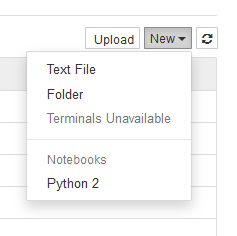Adding the Python 3 engine
Jupyter was originally derived from Python with the IPython project. At that time, Python 2 was the predominant version available for use. For every installation of Jupyter, the default engine provided is Python 2. There are a number of changes involved when moving from Python 2 to Python 3, especially in the underlying libraries that you may be invoking, where parameter and usage changes have occurred.
How to do it...
We will cover the installation of the Python 3 engine and make sure it is running with a script.
Installing the Python 3 engine
Assuming you have installed the standard Jupyter package, you now have Python 2 as the only engine available at the top of the Jupyter portal screen:

To upgrade to Python 3, I used the commands:
conda create -n py3k python=3 anaconda source activate py3k ipython kernelspec install-self
After this, when you start Jupyter, you will have the Python 3 engine choice.
You may prefer to have the Python 2 engine also available. This could...































































